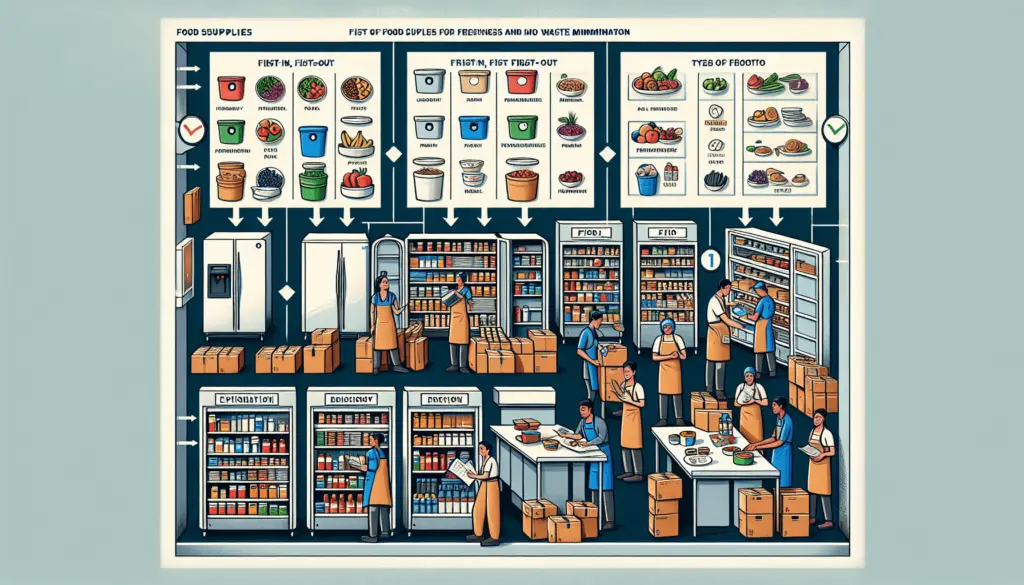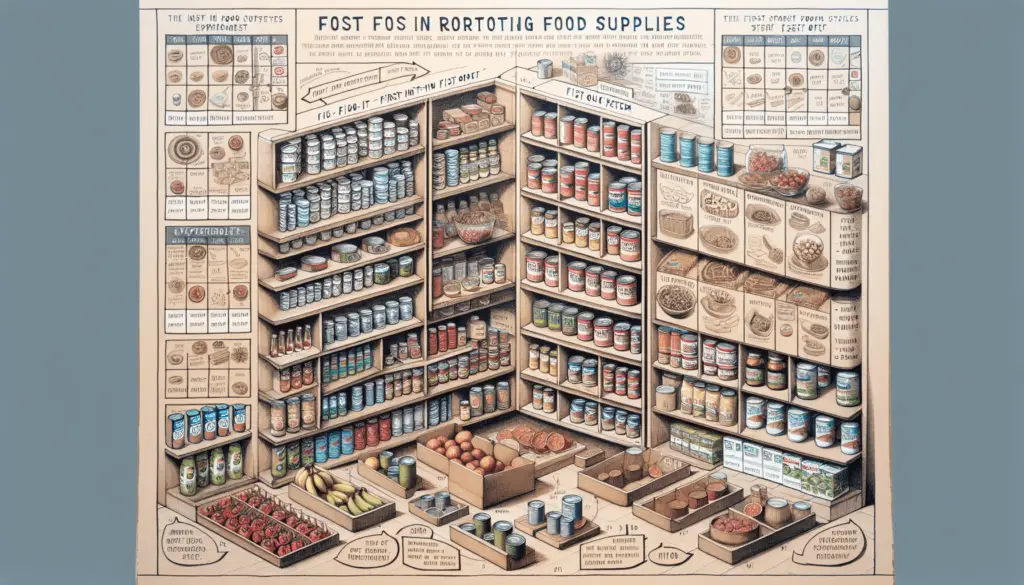If you’re looking to ensure the longevity and freshness of your food supplies, you’ve come to the right place. In this article, we’ll explore the best practices for rotating your food supplies to optimize both taste and safety. By following these simple guidelines, you’ll be able to maintain a well-stocked pantry that’s prepared for any situation and enjoy delicious meals all year round. So, without further ado, let’s dive into the world of food rotation and discover the secrets to preserving your supplies!

Understanding Food Rotation
Definition of food rotation
Food rotation refers to the practice of systematically using food supplies based on their age and shelf life. It involves organizing and categorizing food items to ensure that the oldest products are used first, while the newer ones are stored for future use. By following a proper food rotation system, you can prevent food waste, maintain product quality, and minimize the risk of consuming spoiled or expired items.
Importance of food rotation
Food rotation is crucial for several reasons. Firstly, it helps to prevent foodborne illnesses by ensuring that expired or spoiled food is not consumed. When food sits unused for too long, it can harbor harmful bacteria or become unsafe to eat. Secondly, practicing food rotation promotes efficiency and cost-effectiveness. By using older inventory first, you avoid wastage and reduce the need for replenishing supplies frequently. Additionally, proper food rotation is essential for maintaining the reputation of businesses such as restaurants, catering services, and food retailers. It demonstrates a commitment to food safety and quality, earning the trust and loyalty of customers.
Benefits of proper food rotation
Proper food rotation offers numerous benefits that extend beyond health and safety considerations. By organizing your food supplies and regularly rotating them, you can significantly reduce the amount of food waste generated. This not only saves money but also helps to minimize the environmental impact associated with food disposal. Furthermore, efficient food rotation allows you to make the most of your inventory and avoid unnecessary overstocking, leading to improved cost management. Lastly, by implementing a robust food rotation system, you can enhance the overall quality of your food products, ensuring that they are fresh, flavorful, and meet the highest standards of excellence.
Inventory Management
Creating an inventory system
Creating an effective inventory system is crucial for effective food rotation. Start by establishing a detailed inventory list that includes all the food items you have in stock. This list should be regularly updated as new supplies are purchased or old ones are used up. Consider utilizing technology such as inventory management software or spreadsheets to simplify the process and keep accurate records. It is also important to designate a person or team responsible for overseeing and maintaining the inventory system, ensuring that it remains organized and up-to-date.
Categorizing food supplies
To streamline the food rotation process, it is essential to categorize your food supplies appropriately. One way to categorize is by food type, such as dairy products, meats, fruits, vegetables, grains, and canned goods. Another useful categorization method is by expiration date or shelf life. By grouping together items with similar expiration dates, you can easily identify and prioritize those that need to be used sooner. Additionally, consider labeling each category clearly to facilitate easy identification and retrieval during food rotation.
Labeling and organizing storage areas
Properly labeling and organizing storage areas play a key role in efficient food rotation. Ensure that each food item is clearly labeled with its name, expiration date, and any other pertinent information. This will prevent confusion and reduce the risk of using expired or spoiled items. Organize your storage areas in a way that allows for easy access and visibility of all products. Arrange the items in a manner that follows the first in, first out (FIFO) method, discussed in detail later in this article. By maintaining a well-organized storage system, you can facilitate proper food rotation and minimize the chances of overlooking or forgetting about certain supplies.
Expiration Dates and Shelf Life
Interpreting expiration dates
Understanding expiration dates is essential for effective food rotation. While these dates provide a guideline for freshness and safety, it is crucial to interpret them correctly. The most common types of expiration dates encountered are “sell-by,” “use-by,” and “best-by.” The sell-by date indicates the last day a retailer should sell the product, while the use-by date suggests the last day the product is at its best quality. The best-by date gives an estimate of when the food may start to deteriorate in terms of flavor or texture. It is important to note that expiration dates are not precise indicators of food safety, and many products remain safe to consume for some time beyond the indicated date if stored properly.
Understanding shelf life
Shelf life refers to the length of time a food product can be stored before it deteriorates in quality or becomes unsafe to eat. Shelf life varies depending on the type of food, processing methods, packaging, and storage conditions. Understanding the shelf life of different ingredients and products is crucial for determining their place in the food rotation system. Some items, such as fresh produce, may have a short shelf life and need to be used quickly, while others, like canned goods or freeze-dried items, have a longer shelf life. Refer to product packaging or reliable resources for specific shelf life information to ensure optimal usage and minimize wastage.
Identifying signs of spoilage
When practicing food rotation, it is important to be able to identify signs of spoilage or deterioration. Signs of spoilage can vary depending on the type of food, but common indicators include noticeable changes in color, texture, smell, or taste. Mold, excessive liquid accumulation, foul odors, or unusual tastes should all be considered red flags. Additionally, check for bulging or dented cans, torn packaging, or signs of pest activity, as these can also indicate potential spoilage. If you come across any of these signs, it is best to discard the food item immediately to prevent foodborne illnesses or compromising the quality of your dishes.
First In, First Out (FIFO) Method
Explanation of the FIFO method
The First In, First Out (FIFO) method is a principle that ensures older food products are used before newer ones. It is the foundation of an effective food rotation system. In simple terms, FIFO means that the items stored or purchased first should be the ones used or sold first. By following this method, you can avoid using expired or near-expiration products and minimize the risk of food waste. FIFO can be applied to any food storage area, from refrigerators and pantries to commercial kitchens and food retail establishments.
Benefits of using FIFO
Using the FIFO method offers numerous advantages for managing food supplies. Firstly, it reduces the chances of food spoilage and wastage by ensuring that the oldest items are consumed or sold first. This reduces the need to throw away expired or unsellable products, saving both money and resources. Secondly, FIFO promotes organization and orderliness in food storage areas, making it easier to find specific items and maintain inventory accuracy. Additionally, FIFO implementation demonstrates a commitment to food safety and quality, enhancing the trust and satisfaction of customers or guests.
Implementing FIFO in food rotation
Implementing the FIFO method requires a systematic approach and commitment to the practice. Start by organizing your storage areas, ensuring that the oldest items are placed at the front and easily accessible. Avoid stacking or piling items on top of each other, as this can hinder visibility and lead to accidental neglect of older inventory. Regularly check the labels and expiration dates of products, removing any that are approaching their expiration or sell-by date. Train your staff on the importance of FIFO and provide them with the necessary knowledge and resources to implement it effectively. By incorporating FIFO into your food rotation system, you can achieve maximum efficiency, minimize waste, and maintain the highest standards of food safety.

